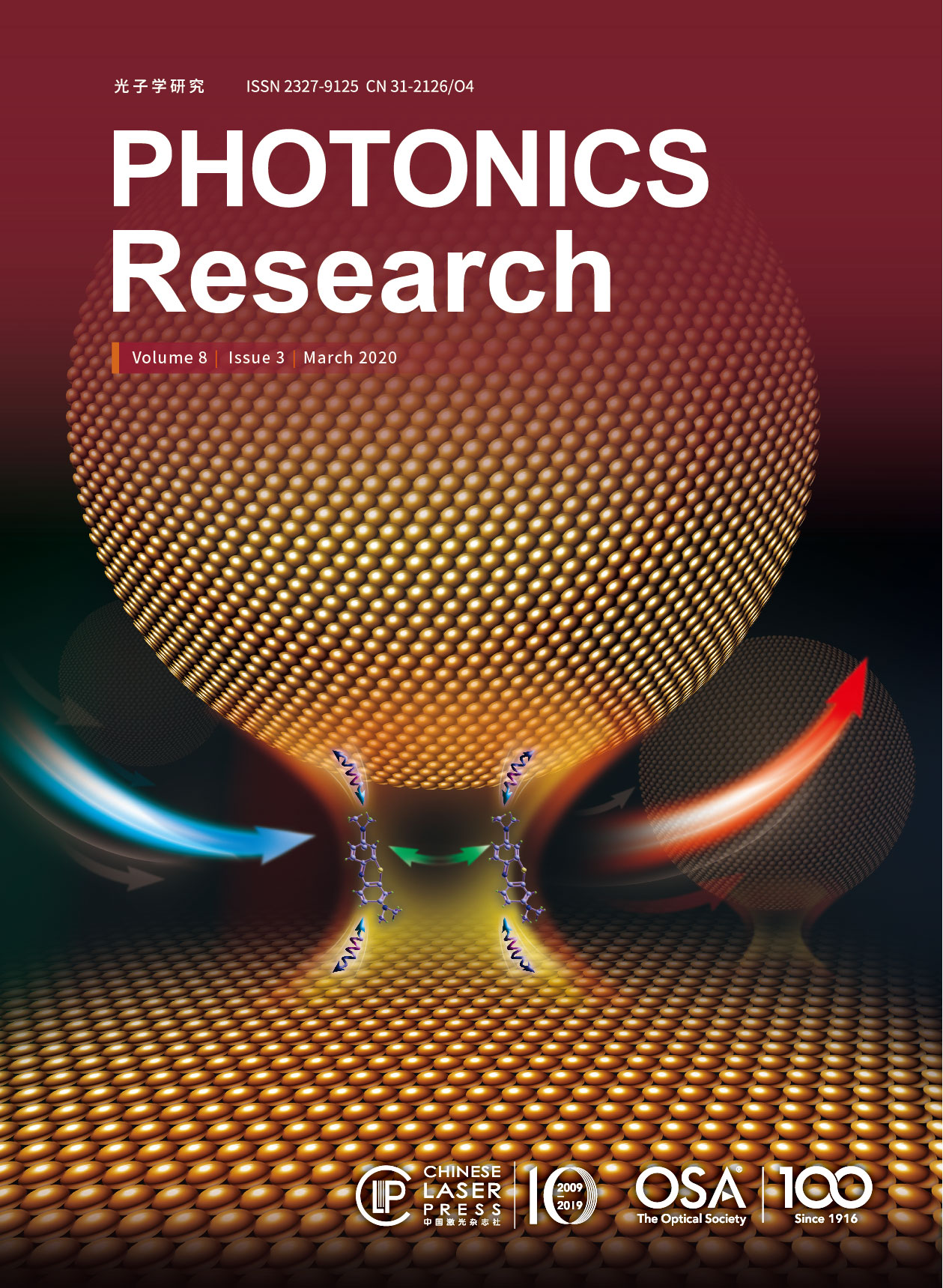The radical suppression of the photodarkening effect and laser performance deterioration via
- Publication Date: Feb. 13, 2020
- Vol. 8, Issue 3, 288 (2020)
Fast and sensitive air-coupled ultrasound detection is essential for many applications such as radar, ultrasound imaging, and defect detection. Here we present a novel approach based on a digital optical frequency comb (DOFC) technique combined with high-
- Publication Date: Feb. 17, 2020
- Vol. 8, Issue 3, 303 (2020)
- Publication Date: Feb. 17, 2020
- Vol. 8, Issue 3, 311 (2020)
- Publication Date: Feb. 28, 2020
- Vol. 8, Issue 3, 426 (2020)
An equivalence is made between the exceptional points proposed by the field of non-Hermitian quantum mechanics and the dead band observed in laser gyroscopes. The sensitivity enhancement near this exceptional point is plagued by increased uncertainty due to broadening of the beat-note bandwidth. Also, near the dead band the gyroscope response is caused by Rabi intensity oscillations and not solely by a phase modulation. Finally, a distinction is made between conservative and non-conservative coupling.
.- Publication Date: Feb. 06, 2020
- Vol. 8, Issue 3, 252 (2020)
- Publication Date: Feb. 05, 2020
- Vol. 8, Issue 3, 225 (2020)
- Publication Date: Feb. 17, 2020
- Vol. 8, Issue 3, 325 (2020)
- Publication Date: Feb. 28, 2020
- Vol. 8, Issue 3, 395 (2020)
- Publication Date: Feb. 17, 2020
- Vol. 8, Issue 3, 318 (2020)
- Publication Date: Feb. 06, 2020
- Vol. 8, Issue 3, 246 (2020)
- Publication Date: Feb. 12, 2020
- Vol. 8, Issue 3, 271 (2020)
- Publication Date: Feb. 12, 2020
- Vol. 8, Issue 3, 279 (2020)
In this paper, a technique combining cascaded energy-transfer pumping (CEP) method and master-oscillator power-amplifier (MOPA) configuration is proposed for power scaling of 1.6-μm-band single-frequency fiber lasers (SFFLs), where the
- Publication Date: Feb. 28, 2020
- Vol. 8, Issue 3, 414 (2020)
- Publication Date: Feb. 28, 2020
- Vol. 8, Issue 3, 421 (2020)
- Publication Date: Feb. 10, 2020
- Vol. 8, Issue 3, 257 (2020)
- Publication Date: Feb. 27, 2020
- Vol. 8, Issue 3, 331 (2020)
- Publication Date: Feb. 27, 2020
- Vol. 8, Issue 3, 368 (2020)
- Publication Date: Feb. 05, 2020
- Vol. 8, Issue 3, 235 (2020)
- Publication Date: Feb. 13, 2020
- Vol. 8, Issue 3, 296 (2020)
- Publication Date: Feb. 27, 2020
- Vol. 8, Issue 3, 338 (2020)
Vacuum Rabi splitting, which stems from a single photon interaction with a quantum emitter (a single atom, molecule, or quantum dot), is a fundamental quantum phenomenon. Many reports have claimed that using J aggregate coupling to highly localized plasmon can produce giant Rabi splitting (in scattering spectra) that is proportional to
- Publication Date: Feb. 27, 2020
- Vol. 8, Issue 3, 343 (2020)
- Publication Date: Feb. 27, 2020
- Vol. 8, Issue 3, 352 (2020)
- Publication Date: Feb. 27, 2020
- Vol. 8, Issue 3, 359 (2020)
Chip-scale, tunable narrow-linewidth hybrid integrated diode lasers based on quantum-dot RSOAs at 1.3 μm are demonstrated through butt-coupling to a silicon nitride photonic integrated circuit. The hybrid laser linewidth is around 85 kHz, and the tuning range is around 47 nm. Then, a fully integrated beam steerer is demonstrated by combining the tunable diode laser with a waveguide surface grating. Our system can provide beam steering of 4.1° in one direction by tuning the wavelength of the hybrid laser. Besides, a wavelength-tunable triple-band hybrid laser system working at
- Publication Date: Feb. 27, 2020
- Vol. 8, Issue 3, 375 (2020)
- Publication Date: Feb. 27, 2020
- Vol. 8, Issue 3, 381 (2020)
Metamaterials play an important role in the modulation of amplitude and group delay in the terahertz (THz) regime on account of their optical properties, which are rare in natural materials. Here an ultrafast anisotropic switch of the plasmon-induced transparency (PIT) effect is experimentally and numerically demonstrated by metamaterial devices composed of two pairs of planar split-ring resonators and a pair of closed-ring resonators. By integration with a germanium (Ge) film, a recovery time of 3 ps and a decay constant of 785 fs are realized in the metadevice. Stimulated by the exterior optical pump, the PIT windows at different frequencies are switched off with an excellent property of slow light for vertical and horizontal THz polarizations, realizing an astonishing modulation depth as high as 99.06%. This work provides a new platform for ultrafast anisotropic metadevices tunable for amplitude and group delay.
.- Publication Date: Feb. 10, 2020
- Vol. 8, Issue 3, 263 (2020)
- Publication Date: Feb. 12, 2020
- Vol. 8, Issue 3, 286 (2020)
- Publication Date: Feb. 28, 2020
- Vol. 8, Issue 3, 412 (2020)
About the Cover
Strong molecule-plasmon quantum interaction together with the molecule-molecule and molecule-plasmon optical interaction in a plasmon nanogap. Generally, the extrinsically visible spectral splitting observed experimentally is not equivalent to the invisible intrinsic energy level splitting of molecule.













